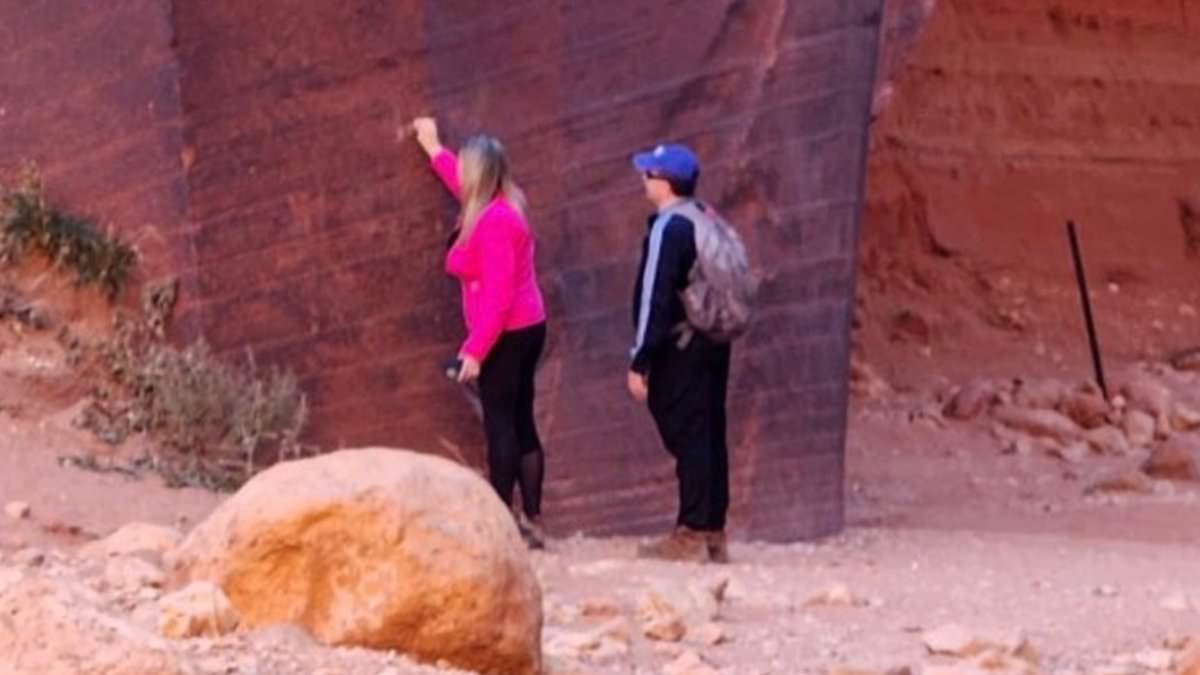Two people who allegedly defaced ancient petroglyphs at a cultural site in southern Utah are being sought by police.
The Kane County Sheriff’s Office received a report on Saturday about a man and a woman who were seen vandalizing ancient Native American rock carvings on a hiking trail.
The walking path is right on the border of Arizona and the carvings were between the Wire Pass and Buckskin Gulch trail heads.
The pair were recorded lingering around the petroglyphs and possibly carving into the rock. They were also later seen in the parking lot.
They reportedly left the area in a black sedan.
Harry Barber, the district manager for the Paria River District, the piece of federal land where this incident occurred, said this behavior is not normal.
‘This is unique and I do want to point that out. The area where this happened in Wire Pass is a popular area,’ he told KUTV.
‘These people were writing their names on the panel, whatever, and members of the public actually when to them and told them “hey, you shouldn’t be doing this” and these individuals blew them off and basically ignored those members of the public,’ he said.

These two individuals, so far unidentified, were caught on camera appearing to vandalize a wall with ancient Native American carvings on it


The suspects were also caught on surveillance in the parking lot before they left in
If anyone recognizes the suspects or their vehicle, they were urged to call the sheriff’s office directly at 435-644-2668.
Federal land managers with the Bureau of Land Management, including Barber, are offering a $1,000 reward for anyone who can offer information that leads to a ‘successful prosecution’ of the suspects.
Buckskin Gulch features about 16 miles of unique formations and undulating sandstone walls,’ according to the Bureau of Land Management.
These walls have carvings of various animals including bighorn sheep that were made centuries ago by Native Americans.
It’s not the first time concerns have been raised about tourists visiting historical sites.
A series of petroglyphs, or rock carvings, made by Native Americans more than 1,000 years ago were found vandalized in Chattahoochee-Oconee National Forests in northern Georgia.
Multiple boulders in Track Rock Gap were found with damage, including five with large scratches and carvings, and two that were painted.
The U.S. Forest Service shared the photos of the destruction on Facebook, writing, ‘We regret to report the vandalism of a protected historic site on the Chattahoochee-Oconee National Forests.’

Southern Utah high desert panorama above Buckskin Gulch on the Utah-Arizona border

The Utah incident comes after multiple boulders in Track Rock Gap were found with damage, including five with large scratches and carvings, and two that were painted
The Tribal Heritage Preservation Office spoke on behalf of the Eastern Band of Cherokee Indians, ‘Whether through ignorance or malice – the result is irreparable damage to a unique site that connects us directly to the people of the past.’
Photos show varying degrees of damage that occurred sometime in 2020 across the rock carvings, including one that displays what appears to be the initials of a couple.
Track Rock Gap is one of the most well-known rock art sites in the Southeastern United States, and is the only one of its kind located on public land in Georgia.
The site, which is about 90 miles northeast of Atlanta, houses the petroglyphs that were found by explorers prior to the year 1800, and the earliest evidence of carvings dates back at least 3,600 years.
Sites on public lands are protected by the Archaeological Resources Protection Act and the damaged rock carvings are considered an irreplaceable part of the nation’s heritage.
